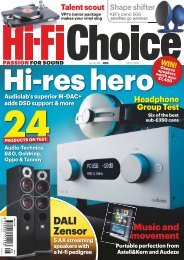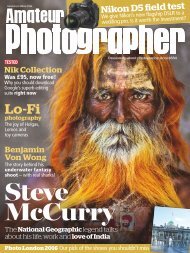You also want an ePaper? Increase the reach of your titles
YUMPU automatically turns print PDFs into web optimized ePapers that Google loves.
TREASURES OF SCORPIUS<br />
The Bug Nebula<br />
(NGC 6302)<br />
The Cat’s Paw<br />
Nebula (NGC 6334)<br />
Through a 6-inch telescope<br />
at low power,<br />
NGC 6302 appears<br />
like a bright galaxy<br />
four times as long<br />
as it is wide, oriented<br />
east to<br />
west. At magnifications<br />
above<br />
150x, the bipolar<br />
nature of this<br />
object is apparent.<br />
Look for a prominent<br />
lobe with a<br />
tapered end on the western<br />
side. Then try to spot<br />
the faint “arm” emerging from<br />
the eastern side. Don’t look for this object’s<br />
central star; intervening dust dims it by<br />
some five magnitudes.<br />
Some named deep-sky objects look<br />
exactly like their namesakes. The<br />
Dumbbell and North America nebulae<br />
come to mind. Add one more — the Cat’s<br />
Paw Nebula (NGC 6334). To find it, look 3°<br />
west-northwest of Shaula.<br />
The Cat’s Paw Nebula<br />
ranks among the Milky<br />
Way’s largest starforming<br />
regions.<br />
It comprises five<br />
individual nebulous<br />
patches in a<br />
circular area. The<br />
brightest, which<br />
Globular<br />
cluster M6<br />
measures 6' across and contains<br />
a 9th-magnitude star, lies<br />
on the southeastern end of the complex.<br />
Because this object is larger than the<br />
Full Moon, you’ll need a wide-field telescope/eyepiece<br />
combination to view it all.<br />
Another approach is to crank up the power<br />
a bit, add a nebula filter, and view each of<br />
the five areas separately.<br />
Our next target, named for the breakfast<br />
cereal it resembles, is the Cheerio<br />
Nebula (NGC 6337). It lies inside the arc<br />
of stars that form the Scorpion’s stinger.<br />
Specifically, you can find it 2° southwest<br />
of magnitude 2.7 Upsilon (υ) Scorpii.<br />
Through a 12-inch telescope at 300x,<br />
you’ll see a thin ring with a superposed<br />
star on both the northeastern and southwestern<br />
edges. A nebula filter like an<br />
Oxygen-III really helps. Although this<br />
object has a low magnitude, its surface<br />
brightness is high.<br />
A bit more than 4° north of our last<br />
target, you’ll find the wonderful Lobster<br />
Nebula (NGC 6357). This gas cloud surrounds<br />
the magnitude 9.6 open cluster<br />
Pismis 24. Some of this cluster’s bright blue<br />
stars are among the most massive ever discovered.<br />
For example, astronomers using<br />
the Hubble Space Telescope discovered a<br />
double star weighing 100 solar masses.<br />
Michael E. Bakich is a senior editor of<br />
<strong>Astronomy</strong>. He will be conducting a viewing<br />
party for the 2017 solar eclipse at Rosecrans<br />
Memorial Airport in St. Joseph, Missouri. See<br />
www.stjosepheclipse.com for details.<br />
M6: LAWRENCE JOHNSON/KATHY ORTEGA/ADAM BLOCK/NOAO/AURA/NSF<br />
62 ASTRONOMY • JUNE 2016






